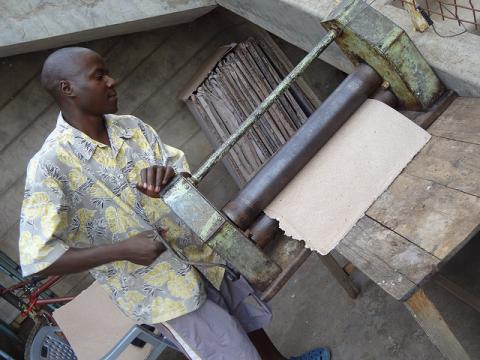Meet the Kenyan Entrepreneur Cashing in on Invasive Plant
Meet Michael Otieno, The Kenyan Entrepreneur Cashing In On Water Hyacinth.
"Lake Victoria is in a sorry state because of the hyacinth, we are trying to do something about it," Michael Otieno tells me as we walk into his business premises in Mambo Leo, Kisumu county where he makes paper from the stubborn weed.

Otieno is the founder and CEO of Takawiri Enterprises Limited. Established in 2006, the enterprise produces unique handmade stationery and craft items from water hyacinth. Some of their products include folders, envelopes, notebooks, seasonal cards, gift bags, and paper lamp shades.
"I am trying to offer a sustainable solution to the hyacinth problem. The government has tried to eradicate it without success. The weed is endangering some fish species such as tilapia by drawing oxygen from the water and blocking sunlight.
"The fish numbers have declined and access to the lake hindered because the weed clogs the lake making it difficult for fishermen to navigate," Otieno says.
He regrets that the local community who depend on the lake for their livelihood are bearing the brunt of the invasive weed.
"During the December holidays, many people went out of business because there was too much hyacinth. Tourists were coming in for boat riding but the boats could not navigate. People were unable to pay rent and school fees for their children," says Otieno.
His efforts have not gone unnoticed. In 2014, he came third in the Green Innovations Awards, organized by the National Environment Trust Fund (NETFUND). He also earned a spot in the 2017 National Science, Technology and Innovation week, where he showcased his products. According to NETFUND, Takawiri Enterprises has managed to control over 20 tons of the hyacinth.
So passionate is this budding innovator that he is convinced his project could eradicate the hyacinth in less than a year while creating employment and conserving the environment by reducing the number of trees used in papermaking.
However inadequate resources to scale up his business continue to challenge that conviction. But for a man who never thought he would own a business of his own in the first place, he remains hopeful.
Born in Nairobi, Otieno moved to Kisumu where he joined Kisumu Boys High School in 1997. He wanted to be an accountant. Barely two years later, his dreams were shattered when his parents were unable to pay his school fees.
Disheartened and out of school, he reluctantly took his uncle's advice to train as an artisan at the Kisumu Innovation Centre of Kenya, KICK (a charitable organization until 2002). His uncle was a painter at the organization.
Otieno joined KICK in 1999. He learned to make woven furniture from hyacinth and papyrus. The training was free and the organization would pay weavers 600 Ksh (about $6) per chair. Trainees would receive half of the amount and the rest would go to their trainers.

It was not long before his dexterity caught the attention of his boss, Mr. Muchilwa. He began to nurture the young man's talent. He would give him orders directly. This meant Otieno would no longer split his pay with his trainers.
After learning that he had dropped out of school, Mr. Muchilwa adviced him to go back.
Having saved some money to pay for school fees, Otieno went back to Kisumu Boys High School in Form 2 in 2002. He continued to work at KICK during the holidays and over the weekends.
Unfortunately, he says, his boss' contract ended a year later and most operations at KICK were halted. He could no longer work at the organization as a part-timer. This dented his prospect of finishing high school.
Although he missed many classes because he would be sent home for school fees most of the time, he managed to sit for his high school exit exams in 2004. He reunited with his former boss who had established his own paper making microenterprise at his home.
"Mr. Muchilwa adviced me to join him to learn more about paper recycling. He trained me in blending waste paper with hyacinth fiber. After working with him for 3 years, he advised me to start a business of my own." says Otieno.
Although he was skeptical of going it alone, he embarked on getting equipment. He bought a small trough, a pestle, and mortar.
"I was not clear about what to do. I was young at the time and trying to venture into business for the first time. But l had nothing else to do, l decided to do it anyway." Otieno says.
He began to manually blend waste paper and hyacinth from his residence in Migosi, Kisumu, producing business cards, book covers and envelops. The process was labor intensive because he lacked the necessary machines.
After the NETFUND awards, he received some seed money from the agency which enabled him to fabricate a calendaring machine and a pulping machine. This enhanced the production process greatly. The agency also supported him to undertake a one-year business course.
With the seed money, he also rented a 0.25ha piece of land in Mambo Leo, Kisumu where he moved the business. He also added gift bags to his line of products.
One of the major challenges Otieno faces is the inability to produce in bulk. He operates on a made-to-order basis. He regrets failing to secure business contracts with companies who wanted eco-friendly packagings when the ban on plastic bags came into effect in 2017.
"At the moment we can only make 200 pieces of paper per day. Once we get the pulp, we make the paper manually but there is a machine that can give us up to 3000 pieces of paper in a day," says Otieno.
For now, with 5 permanent employees, Otieno makes Ksh. 60,000 on average per month. He believes he could make up to Ksh. 100,000 per day once he acquires the necessary machines. By mechanizing the entire process he says, he will be able to hire more workers and expedite the eradication of the hyacinth from the lake.
How it works.
- Hyacinth is cut into small pieces before it is dried in the sun. When the weather is not conducive for drying, the weed is boiled for 3 hours.
- Waste paper is added. The mixture is crushed to produce pulp before adding wood glue to bind it.
- The pulp is put into a trough filled with water.
- The mixture is sieved. The A-3 size sieves are put in the sun to allow the residue to dry, forming paper.
- The paper is then passed through a calendaring machine where pressure is exerted to it leaving it smooth and foldable.

